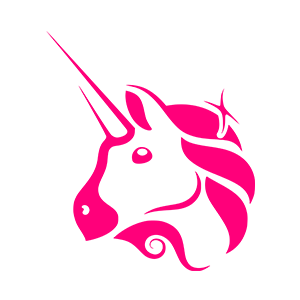
Uniswap Protocol Token
Uniswap Protocol Token Price Converter
Uniswap Protocol Token Information
Uniswap Protocol Token Markets
Uniswap Protocol Token Supported Platforms
| ABUNI | ERC20 | ARB | 0xFa7F8980b0f1E64A2062791cc3b0871572f1F7f0 | 2021-06-16 |
| BPUNI | BEP20 | BNB | 0xbf5140a22578168fd562dccf235e5d43a02ce9b1 | 2020-10-13 |
| BPUNI | BEP2 | BNB | UNI-DD8 | 2020-10-13 |
| HPUNI | HRC20 | HT | 0x22c54ce8321a4015740ee1109d9cbc25815c46e6 | 2021-02-06 |
| MUNI | ERC20 | MOVR | 0xabd380327fe66724ffda91a87c772fb8d00be488 | 2021-09-13 |
About Uniswap Protocol Token
Uniswap minted a total of 1 billion UNI at its launch, which it expected to distribute over the course of four years. Sixty percent of all UNI will be distributed to community members, while the remaining 40% will be for investors, advisers, and Uniswap team members. Once the total of 1 billion UNI is distributed, UNI will be an inflationary token with a perpetual inflation rate of 2%.
Uniswap’s protocol token went live in September 2020. In the subsequent months, it captured the bull run of the wider crypto market. The Uniswap price climbed to an all-time high of $45.01 on May 4 before pulling back along with the broader crypto market that month. The price of Uniswap fluctuated in the $15-$30 range during the summer of 2021.
Uniswap runs on two smart contracts – “Exchange” and “Factory” – automated computer programs that perform certain functions when preset conditions are met. The factory smart contract adds new tokens to the platform, while the exchange one facilitates token trades.
The protocol offers “time-weighted average price” (TWAP) oracles, a pricing methodology that calculates the average price of an asset over a set period. Oracles are a tool that brings data from an outside source into a blockchain.
Uniswap’s consensus mechanism is similar to a proof-of-stake model, in which users receive rewards in return for locking up their tokens.
UNI token holders can participate in on-chain governance for future upgrades to the Uniswap protocol. Further, UNI holders also obtain partial ownership of the Uniswap domain and set the token list for the Uniswap exchange.
Beyond governance, UNI holders are entitled to around one-sixth of the trading fees paid on the Uniswap Protocol. However, governance controls require that holders vote to agree on when they receive funds. The community is also encouraged to consult legal and regulatory professionals before implementing proposals.
The Uniswap team doesn’t participate directly in the development or the governance of the protocol. However, it reserves the right to delegate votes, without seeking to influence voting decisions.
In 2016, the concept for an on-chain AMM was theorized by Ethereum co-founder Vitalik Buterin in a post on Reddit. The concept was different from decentralized exchanges in that it doesn’t use a traditional order book. Hayden Adams began working on the concept after he was laid off from his job as a mechanical engineer and was encouraged to learn how to code by Ethereum Foundation member Karl Floersch. Eventually, Adams received multiple grants from the Ethereum Foundation and others to build it into a functional exchange. On Nov. 2, 2018, Hayden publicly announced Uniswap and launched it on the Ethereum blockchain.
Uniswap v2 launched in May 2020. It facilitated over $135 billion in trades and gave Uniswap the title of the largest decentralized spot exchange in the world. A year later, Uniswap v3 launched on the Ethereum blockchain with the aim of making transactions on Uniswap cheaper and faster.
Before its upgrade to V3, the protocol raised $11 million in August 2020 in a Series A funding round led by venture capital firm Andreessen Horowitz.